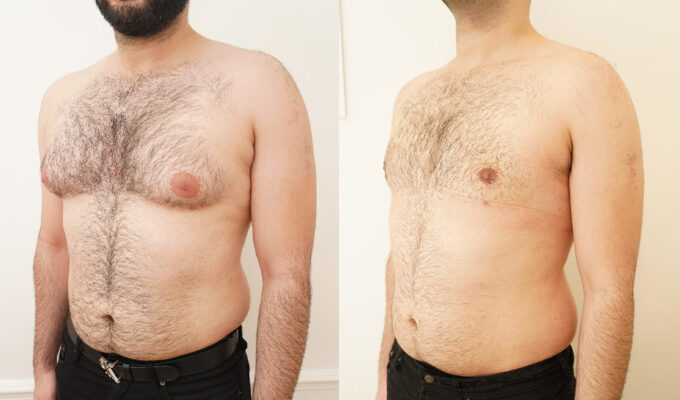
Gynecomastia correction
Cure for gynecomastia by liposuction and gland excision
Gynecomastia affects many men and can vary in severity, often causing discomfort and self-consciousness in daily life. Surgery for gynecomastia corrects this excess fat and glandular tissue in the chest area.

Gynecomastia is defined by the abnormal development of the mammary gland in men. This condition occurs when a man produces too much estrogen compared to the amount of testosterone. The result of this hormonal imbalance is the development of breast glands.
Gynecomastia varies in severity, from mild breast tissue enlargement to significant breast hypertrophy in men. It affects one in two men. In most cases, gynecomastia appears during puberty (around 12 years old) and usually resolves by the end of puberty (around 17 years old). However, it can persist beyond this age, causing significant issues for young men, whether overweight or not, due to the impact on self-confidence.
The causes of gynecomastia in men can be multiple:
Therefore, before any treatment for gynecomastia, it is essential to undergo a complete evaluation by an endocrinologist to rule out any secondary causes. This evaluation includes a comprehensive hormonal assessment, mammography, and breast ultrasound.
Consulting a specialist in gynecomastia surgery is crucial for optimal care. The imaging assessment will help characterize the type of gynecomastia, which can have two components:
The surgical correction of gynecomastia varies depending on the type of gynecomastia present.
In the case of adipomastia (primarily fatty gynecomastia), a simple liposuction of the chest is sufficient.
For mixed gynecomastia (adipomastia and excess glandular tissue), chest liposuction is combined with an incision around the areola to remove the gland.
In rare cases, gynecomastia is solely due to hypertrophy of the mammary gland (glandular gynecomastia). In such cases, a simple incision around the areola allows for the removal of the gland.
If there is significant excess skin, larger incisions will be necessary to tighten the skin.
During the initial consultation with Dr. Benjamin Sarfati, the feasibility of the treatment is assessed, and it is confirmed that the condition is indeed due to fatty tissue.
For gynecomastia, the surgical treatment is performed in the operating room under general anesthesia. The patient arrives at the clinic on the morning of the surgery and is discharged in the evening (outpatient surgery) or the following day if drains have been placed. Gynecomastia surgery lasts between 1 to 1.5 hours.
After gynecomastia surgery, it is necessary to wear a compression garment for 1 month. Pain is generally moderate and can be effectively managed with standard painkillers.
Following the surgery, mild swelling and bruising may appear on the chest. Rest for a few days post-operation is recommended, and a work leave of 1 to 2 weeks will be prescribed. It is advised to avoid sports and baths (showers are permitted) for 1 month after the surgery. You can move your arms and walk the day after the procedure, but strenuous activities and heavy lifting should be avoided. Gentle massages of slightly sore areas can help promote faster recovery.
The results of gynecomastia surgery (male breast reduction) are visible as soon as the day after the procedure. The breast tissue should have returned to a more normal appearance, with the gland reduced to a small, discreet size.
However, the final result is only apparent after several weeks. It typically takes about one month for the swelling to completely subside, especially in cases of adipomastia (fatty gynecomastia) where intensive liposuction was performed.
Additionally, the excess skin may take a similar amount of time to retract fully. After this period, you will achieve a more masculine chest and feel comfortable going shirtless without embarrassment.
The cost of male gynecomastia surgery (including for adipomastia) varies depending on the technique used. The price will be higher if excess skin needs to be removed.
In cases of confirmed gynecomastia (presence of breast tissue), the procedure may be covered by health insurance. Additional fees may be partially or fully reimbursed by your supplementary health insurance. Social security typically covers clinic fees, operating room costs, and part of the surgeon’s fees.
However, if only liposuction is performed (for adipomastia), the procedure is considered cosmetic surgery and is not covered by social security. In this case, the surgery is not reimbursed by health insurance.
The cost of gynecomastia surgery can range from €1,000 to €3,500.

DOCTOR BENJAMIN SARFATI
Specialist in breast surgery and intimate surgery
Make an appointment
Make an appointment in person or by teleconsultation :